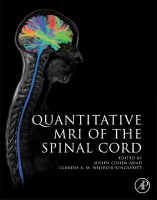Physical Address
304 North Cardinal St.
Dorchester Center, MA 02124

You’re Reading a Preview Become a Clinical Tree membership for Full access and enjoy Unlimited articles Become membership If you are a member. Log in here

5.1.1 Magnetic Resonance Spectroscopy 5.1.1.1 Introduction In the large majority of applications MRI focuses on detecting proton signal, in particular the signal from water protons. It therefore provides information about anatomical structure and the biophysical state of tissue water. Magnetic…

4.3.1 Rationale Spinal cord blood vessels are millimeter- to submillimeter-sized blood vessels that are hard to visualize in the human body. In vivo imaging of spinal cord arteries and veins was until recently only possible using invasive catheter-based angiography, which…

4.2.1 What is Physiological Noise? Physiological noise can be defined as any signal change occurring in an image that is due to the subject and that is of no interest. Equally, movement of the subject (e.g., bulk movement of the cord)…

4.1.1 Blood Oxygenation Level Dependent 4.1.1.1 Basic Principles Functional magnetic resonance imaging (fMRI) allows noninvasive detection of neuronal activity. fMRI based on the blood oxygenation level dependent (BOLD) contrast mechanism was first introduced in 1990. The basic principle behind the…

3.6.1 Historical Perspective Since the early days of X-ray computerized tomography (CT) in the late 1970s, it has been possible to visualize the spinal cord in cross-section in vivo, and to make quantitative measurements of the cord diameter. Early studies…

3.5.1 Overview T 2 -weighted imaging plays a key role in clinical MR imaging of spinal cord. While T 2 weighting is highly sensitive, it is notoriously unspecific as very different pathological conditions can lead to similar increases in water…

Magnetization transfer (MT), first demonstrated in vivo by Wolff and Balaban, is a contrast mechanism based on the exchange of magnetization occurring between groups of spins characterized by different molecular environments. MT produces a source of contrast alternative to T…

3.3.1 Introduction: Diffusion Imaging and Tissue Microstructure Diffusion imaging and particularly diffusion tensor imaging (DTI) have become standard tools for assessment of white matter in the brain. Although somewhat more technically challenging to implement in the spinal cord, these methods…

In Chapter 3.1 , the diffusion of water molecules was described according to the diffusion tensor model, which assumes a Gaussian probability of displacement associated to the diffusion of water molecules. This assumption is true in free systems, but it…